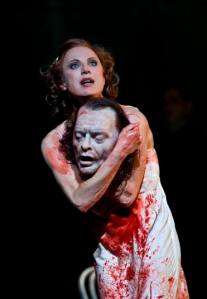‘Women were not only writing, they were conceiving fictional worlds in which patriarchal images and conventions were severely, radically revised’ (Sandra Gilbert and Susan Gubar)
‘SALOME’
Sexuality is most typically expressed through bodily activity that is linked to the lower strata, and Gilbert and Gubar argue that ‘the monster may not only be concealed behind the angel, she may actually turn out to reside within (or in the lower half of) the angel’.[1] The passive ‘angel’ is not so passive after all; the ‘monster’ resides within, specifically located within the lower strata and thus aligned with bodily sexual activity. The patriarchal suppression of such seductive and sexual wiles stems from what Gilbert and Gubar identify as a ‘male dread of women’, stemming from ‘male ambivalence about… traditional images of such terrible sorceress-goddesses as the Sphinx, Medusa, Circe, Kali, Delilah, and Salome, all of whom possess duplicitous arts that allow them both to seduce and to steal male generative energy’ (Madwoman 823). The man therefore dreads not so much the ‘shameful’ lower strata but, rather, female sexual dominance, and these dominant female figures thus find themselves designated as the marginal other; the ‘terrible’, terrifying, undesirable ‘monster’.
It cannot be ignored that, of the list provided by Gilbert and Gubar, Carol Ann Duffy’s The World’s Wife pays tribute to four out of the six; a majority representation. ‘Salome’, as one of this party (and in fact the same can be said for ‘Circe’, ‘Delilah’, and ‘Medusa’ also), is not a ‘Mrs’. Unmarried, these ‘monsters’ (and to be fair, Salome’s murderous act is certainly neither angelic nor neutral), are not the possession of another, nor defined by any man; they have each their own voice, dictated through poetry, and their own individuality.
Salome’s monstrous actions serve to undermine the male figure while empowering herself. The male figure is literally a severed body-part and a question mark: ‘a head on the pillow besides me – whose?’[2] While Salome has the power to speak, the man has no identity at all. Salome is cold and calculating, and a serial killer:
I’d done it before
(and doubtless I’ll do it again,
sooner or later)
(World’s Wife 56)
Salome epitomises the seductive ‘monster’ that Gilbert and Gubar describe. She steals away the man’s generative energy; she literally cuts away his head from the body where the lower strata (indicative of sexual activity) is located. His mouth is one that ‘obviously knew how to flatter…’ (World’s Wife 56). The use of ellipsis here undermines the flirtatious powers that are attributed to the unnamed man through this statement; it incites the reader to pause… a hesitation that makes this ‘obvious’ fact a little more uncertain. Salome then takes control; his ‘beautiful crimson mouth’ is the object of desire, she is the one who leans in for the kiss. Already we can identify the shift in power; the roles are reversed and the man is the ‘[c]older than pewter’ corpse/statue while the female Salome takes on the role of seductress.
Salome’s narrative takes place between ‘sticky red sheets’ (World’s Wife 57), and this exaggerated, grotesquely ‘sticky’ blood serves to break down the sexual power dynamics between sexes even further. Julie Kristeva cites menstrual blood as that which ‘stands for danger issuing from within the identity (social or sexual); it threatens the relationship between the sexes’ by highlighting the sexual difference between the two through an internalised action that slowly manifests in an abject, corporeal process; blood trespasses beyond the boundaries of the container (the body).[3] Blood between the sheets (either menstrual or virgin) typically signifies the female as the subjected individual (or object) of sexual advances… but Salome tells a different story. Gubar and Gilbert argue that ‘[t]he “killing” of oneself into an art object… testifies to the efforts women have expended not just trying to be angels but trying not to become female monsters’ (Madwoman 823). As such, women conform to the image of ‘angel’ so as to appear positively in the eyes of the man that fear the uncontrollable, undesirable ‘monster’. Salome makes no such attempts; she reclaims her bed through the use of the possessive apostrophe – ‘Salome’s bed’ (World’s Wife 57) – and the blood, once a symbol of feminine subjection, is a consequence of murder. Mikhail Bakhtin argues that ‘[t]o degrade is to bury, to sow, and to kill simultaneously, in order to bring forth something more and better’.[4] Degradation manifests in the sexual activity that is located within the lower strata, but also in the blood that pours forth from the orifices created by the severing of the head. This action of severance literally kills, but also sows the seeds, the blood, amongst the sheets in a monstrous action that defies the ‘angel’ image and which pronounces the extreme individuality of Salome. Salome kills while simultaneously taking control of both her sexual and individual identity.
……………………………………………………………………
[1] Sandra Gilbert and Susan Gubar, ‘The Madwoman in the Attic’, in Literary Theory: An Anthology, 2nd edn, ed. Julie Rivkin and Michael Ryan (Oxford: Blackwell Publishing, 2004), p.820
[2] Carol Ann Duffy, ‘Salome’, The World’s Wife (Basingstoke and Oxford: Picador, 1999), p.56
[3] Julie Kristeva, Powers of Horror: An Essay on Abjection, trans. Leon S. Roudie (New York: Columbia University Press, 1982), p.71
[4] Mikhail Bakhtin, ‘Rabelais and His World’, Literary Theory: An Anthology, 2nd edn, ed. Julie Rivkin and Michael Ryan (Oxford: Blackwell Publishing, 2004), p.688

